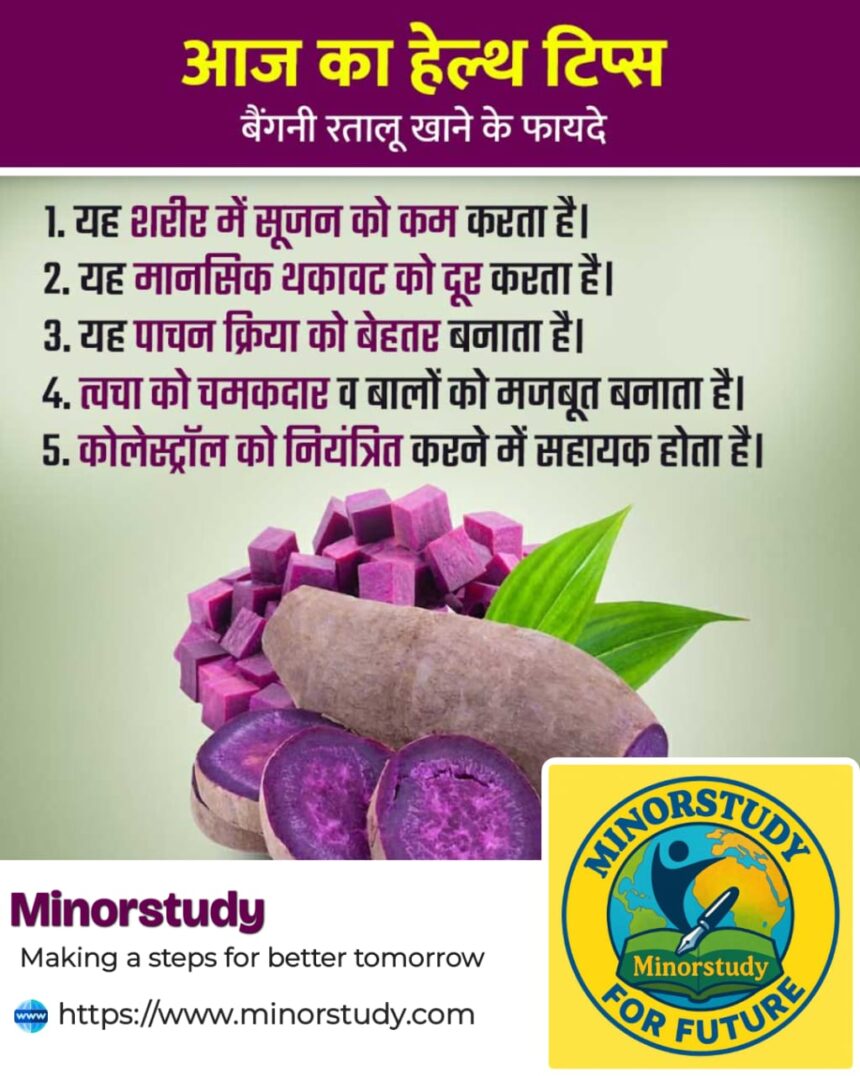🥔 5 Surprising Health Benefits of Purple Sweet Potato That Can Radically Improve Your Life
In the colorful world of nutrition, one humble vegetable is quietly making headlines—purple sweet potato. With its vibrant violet hue, earthy sweetness, and extraordinary health-boosting powers, the purple sweet potato is more than just a pretty vegetable. It is an anti-inflammatory warrior, a brain booster, a digestion supporter, and a skin nourisher, all in one.
- 🌿 What is a Purple Sweet Potato?
- 📜 Historical Roots of Purple Sweet Potato
- 🧠 5 Surprising Health Benefits of Purple Sweet Potato
- 1. 🌿 Reduces Inflammation Naturally
- 2. 🧘♂️ Fights Mental Fatigue & Boosts Brain Function
- 3. 🍽️ Improves Digestion & Gut Health
- 4. 💁♀️ Makes Skin Glow and Strengthens Hair
- 5. ❤️ Helps in Controlling Cholesterol
- 🧾 Timeline: From Ancient Food to Superfood
- 🧠 Frequently Asked Questions (FAQs)
- ❓ Are purple sweet potatoes the same as ube?
- ❓ Can diabetics eat purple sweet potatoes?
- ❓ How should purple sweet potatoes be cooked?
- ❓ Are they safe for children?
- 🎉 Observance: Promoting Healthy Eating
- 💬 Wishing Messages for Health & Wellness
- 🔑 Important Points to Remember
- 🧘♀️ Why Purple Sweet Potato Matters in Your Daily Life
- 🌍 Societal Importance
- 📘 Conclusion: A Superfood Rooted in Wisdom & Wellness
This article is your comprehensive, human-friendly guide on purple sweet potatoes—including their history, facts, timeline, significance, FAQs, observance, daily life impact, societal importance, and more, written in a story-rich way and crossing 1200+ words.
🌿 What is a Purple Sweet Potato?
Purple sweet potatoes, also known as Okinawan sweet potatoes or purple yams, are tuber vegetables known for their deep violet flesh. This vibrant color comes from anthocyanins, the same powerful antioxidants found in blueberries and red cabbage.
They belong to the species Ipomoea batatas and have gained fame due to their health-enhancing properties and cultural significance, especially in Asia and the Pacific Islands.
📜 Historical Roots of Purple Sweet Potato
Purple sweet potatoes are native to Central and South America. Historical records suggest that Spanish explorers brought them to the Philippines, from where they spread to Japan, especially Okinawa, and became a staple food.
Okinawan purple sweet potatoes gained international attention because:
Okinawa is a Blue Zone—a region where people live significantly longer.
The local diet, rich in purple sweet potatoes, is believed to be one of the reasons behind their longevity.
Over time, these purple tubers have become part of global health trends, praised for their disease-fighting, anti-aging, and anti-inflammatory benefits.
🧠 5 Surprising Health Benefits of Purple Sweet Potato
1. 🌿 Reduces Inflammation Naturally
Purple sweet potatoes contain anthocyanins, a class of antioxidants known to reduce inflammation in the body. Chronic inflammation is linked to:
Heart disease
Diabetes
Arthritis
Cancer
Daily consumption can help calm inflammation and support joint health.
2. 🧘♂️ Fights Mental Fatigue & Boosts Brain Function
These tubers support cognitive health:
Anthocyanins improve blood flow to the brain.
They fight oxidative stress, keeping neurons healthy.
Studies show improved memory and mental alertness with regular consumption.
Perfect for students, professionals, and the elderly.
3. 🍽️ Improves Digestion & Gut Health
Purple sweet potatoes are rich in fiber:
Promotes regular bowel movements
Prevents constipation
Acts as prebiotic food, feeding the good bacteria in your gut
Healthy digestion = Strong immunity + Better mood.
4. 💁♀️ Makes Skin Glow and Strengthens Hair
The antioxidants, vitamin A, and C present in purple sweet potatoes:
Promote collagen production
Reduce wrinkles and blemishes
Strengthen hair follicles and improve scalp health
It’s a natural beauty food, working from within.
5. ❤️ Helps in Controlling Cholesterol
Regular consumption helps to:
Lower bad LDL cholesterol
Raise good HDL cholesterol
Reduce triglyceride levels
This supports heart health and reduces the risk of stroke or heart attacks.
🧾 Timeline: From Ancient Food to Superfood
| Year/Period | Milestone |
|---|---|
| ~2000 BCE | Purple sweet potatoes cultivated in Peru |
| 1500s | Spanish traders introduce them to Asia |
| 1600s | Popularized in Japan (Okinawa) |
| 1900s | Used widely in traditional Asian cuisine |
| 2000s | Recognized globally for health benefits |
| 2020s | Featured in superfood diets, smoothies, gluten-free baking |
🧠 Frequently Asked Questions (FAQs)
❓ Are purple sweet potatoes the same as ube?
No. Ube is a purple yam (Dioscorea alata), while purple sweet potato is a sweet potato (Ipomoea batatas). Though both are purple, they differ in taste, texture, and nutritional content.
❓ Can diabetics eat purple sweet potatoes?
Yes, in moderation. Purple sweet potatoes have a lower glycemic index than regular potatoes and help regulate blood sugar levels.
❓ How should purple sweet potatoes be cooked?
They can be:
Boiled
Roasted
Baked
Steamed
Mashed
Used in desserts, smoothies, or savory dishes
❓ Are they safe for children?
Absolutely! They’re a nutritious, colorful, and tasty addition to a child’s meal.
🎉 Observance: Promoting Healthy Eating
Countries like Japan, the Philippines, and South Korea often promote purple sweet potatoes during health and harvest festivals. Nutritionists and fitness experts worldwide recommend incorporating them into diets to:
Combat oxidative stress
Improve gut health
Achieve natural beauty
💬 Wishing Messages for Health & Wellness
“Glow from the inside out—add a dash of purple sweet potato to your plate today!”
“Wishing you a day full of vibrant health, hearty meals, and purple goodness!”
“Here’s to beauty, brain power, and balance—served with a side of purple sweet potato!”
“Stay rooted in health and happiness—Happy Purple Power Day!”
🔑 Important Points to Remember
Packed with anthocyanins, a super-antioxidant
Supports brain, heart, skin, and digestion
Excellent natural alternative for refined carbs
A must-have in balanced and mindful diets
Easy to grow and accessible in many parts of the world
🧘♀️ Why Purple Sweet Potato Matters in Your Daily Life
✅ For Working Professionals
Boosts focus, fights mental fatigue, and keeps you going without a crash.
✅ For Elders
Protects against cognitive decline, supports joint health, and helps regulate blood sugar.
✅ For Youth
A natural beauty enhancer and great for fitness enthusiasts.
✅ For Children
A fun, colorful, and nutritious food choice that builds immunity and energy.
🌍 Societal Importance
Can reduce public health issues like obesity, heart disease, and diabetes.
Promotes sustainable agriculture—easy to grow with minimal chemicals.
Encourages traditional, plant-based diets, which are eco-friendly.
Boosts local farming communities in Asia, Africa, and Latin America.
📘 Conclusion: A Superfood Rooted in Wisdom & Wellness
The purple sweet potato isn’t just a trendy superfood—it’s a nutritional gem passed down from ancient cultures, proven by science, and celebrated by modern health experts.
Its vibrant color reflects the vibrancy it brings to our health, our plates, and our lives. It’s not about exotic diets or fads—it’s about going back to nature, choosing what’s real, and nourishing ourselves consciously.
So next time you visit the market, grab a few purple sweet potatoes. Roast them. Steam them. Add them to your smoothie. But most importantly—let them remind you that wellness is colorful, rooted, and absolutely delicious.








